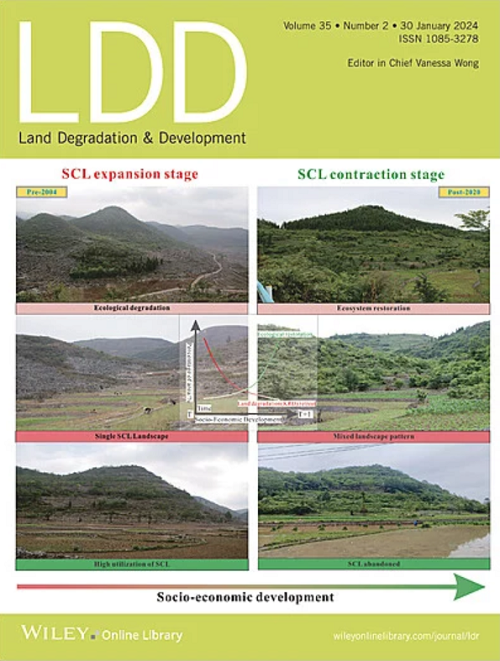Soil Erosion Responses to CMIP6 Climate Scenarios and Land Cover Changes in the Gidabo Watershed, Ethiopia: Implications for Sustainable Watershed Management
IF 3.6
2区 农林科学
Q2 ENVIRONMENTAL SCIENCES
引用次数: 0
Abstract
Soil erosion, driven by climate and land cover changes, poses a significant challenge to watershed sustainability. This study assessed historical and projected soil erosion in Ethiopia's Gidabo Watershed using climate data from an ensemble of six GCMs and Landsat images (2003, 2011, and 2019), which were classified and predicted by integrating the Random Forest classifier and Google Earth Engine, and the InVEST‐SDR model to evaluate erosion potential. Historical and future land cover change projections revealed a trend of increasing agricultural and built‐up areas, while dense vegetation exhibited a declining trend. The average annual precipitation in the baseline scenario showed an insignificant decreasing trend, whereas future projections indicated an overall increase. Soil erosion was assessed for both baseline and future periods by integrating CMIP6 GCMs (SSP2‐4.5 and SSP5‐8.5) with land cover maps. The results indicated that the mean annual soil loss increased from 18.74 t ha埃塞俄比亚Gidabo流域土壤侵蚀对CMIP6气候情景和土地覆盖变化的响应:对流域可持续管理的启示
气候和土地覆盖变化导致的土壤侵蚀对流域的可持续性构成重大挑战。本研究利用六个gcm和Landsat图像(2003年、2011年和2019年)的气候数据对埃塞俄比亚Gidabo流域的历史和预测土壤侵蚀进行了评估,这些数据通过随机森林分类器和谷歌Earth Engine以及InVEST‐SDR模型进行分类和预测,以评估侵蚀潜力。历史和未来土地覆盖变化预测结果显示,农业和建成区面积呈增加趋势,而植被密度呈下降趋势。在基线情景中,年平均降水量呈现不显著的减少趋势,而未来的预估则显示总体增加。通过整合CMIP6 GCMs (SSP2‐4.5和SSP5‐8.5)和土地覆盖图,对基线和未来时期的土壤侵蚀进行了评估。结果表明,在SSP2‐4.5条件下,平均年土壤流失量从基线期的18.74 tha−1 yr−1增加到2030年代的22.75 tha−1 yr−1和2050年代的24.76 tha−1 yr−1。在SSP5‐8.5条件下,2030年代土壤侵蚀速率达到23.12 t ha−1 yr−1,2050年代土壤侵蚀速率达到25.42 t ha−1 yr−1。这种增长是由农业扩张、植被覆盖减少和高降雨侵蚀力驱动的。土壤侵蚀速率高的地区集中在西南和东北流域,严重侵蚀地区需要立即采取保护措施。重新造林、梯田和可持续土地管理对于缓解土壤侵蚀和增强流域恢复力至关重要,为有针对性的保护战略和可持续流域管理提供了关键见解。
本文章由计算机程序翻译,如有差异,请以英文原文为准。
求助全文
约1分钟内获得全文
求助全文
来源期刊

Land Degradation & Development
农林科学-环境科学
CiteScore
7.70
自引率
8.50%
发文量
379
审稿时长
5.5 months
期刊介绍:
Land Degradation & Development is an international journal which seeks to promote rational study of the recognition, monitoring, control and rehabilitation of degradation in terrestrial environments. The journal focuses on:
- what land degradation is;
- what causes land degradation;
- the impacts of land degradation
- the scale of land degradation;
- the history, current status or future trends of land degradation;
- avoidance, mitigation and control of land degradation;
- remedial actions to rehabilitate or restore degraded land;
- sustainable land management.
 求助内容:
求助内容: 应助结果提醒方式:
应助结果提醒方式:


